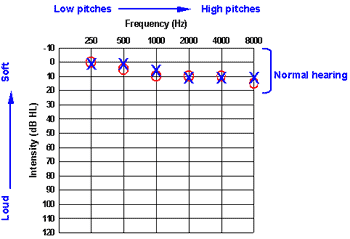The Impaired Ear
Hearing loss can be caused by many things—viruses and bacteria, disease processes, trauma, certain types of (ototoxic) medications, noise and genetic factors. Hearing loss can be present at birth (congenital), or it can occur any time during life (acquired). Acquired hearing loss can develop slowly over time (progressive) or it can happen suddenly. Hearing loss can occur in one ear (unilateral) or both ears (bilateral). Bilateral hearing loss may be the same in both ears (symmetric) or the
type and degree of hearing loss can differ between ears (asymmetric). Some forms of hearing loss affect only certain frequencies (pitches) and other forms of hearing loss affect all frequencies. The degree of hearing loss can range from mild to profoundly deaf.
The Audiogram
An audiogram is a graph of hearing thresholds at different frequencies. Threshold is the softest sound a person can hear. Threshold is measured for each ear at octave frequencies between 250 Hz (low pitches) and 8000 Hz (high pitches). The normal human auditory system is capable of hearing sounds between 20 Hz and 20,000 Hz, but hearing is generally only tested clinically at 250-8000 Hz because those frequencies are the most important for understanding speech.
Threshold measures are plotted on the audiogram using different symbols to represent each ear and how the sound was delivered to the ear (e.g., through earphones, speakers, etc.). In the audiogram below, red circles represent thresholds through earphones for the right ear, and blue X’s are thresholds for the left ear. The audiogram below shows an example of hearing thresholds within the normal range. The cutoff for normal hearing is generally 20 dB HL. The farther the symbols are toward the bottom of the audiogram, the more hearing loss a person has.

Hearing and Balance
